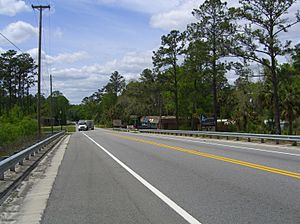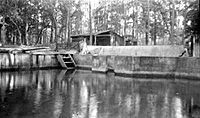Newport, Florida facts for kids
Quick facts for kids
Newport, Florida
|
|
|---|---|

Westbound US 98 as it enters Newport from the George Nesmith Bridge.
|
|
| Country | United States |
| State | Florida |
| Counties | Wakulla |
| Time zone | UTC-5 (EST) |
| • Summer (DST) | UTC-4 (EDT) |
Newport is a small unincorporated community in Wakulla County, Florida, United States of America, situated where U.S. Highway 98 meets State Road 267.
History
1840s
In 1841, the current Newport area and the community of Port Leon, just south, endured a severe yellow fever epidemic. In 1843 Port Leon, located on the St. Marks River, was devastated by a hurricane that produced a 10-foot storm surge. The area still struggles against the same recurring hurricane surges that move up the St. Marks River entrance.
After the hurricane of September 13, 1843, washed away all of the homes, buildings and railroad tracks in Port Leon promoters Nathaniel Hamlin, James Ormond, Peter H. Swain and several others met a week later and made plans to establish another town.
They spent several days searching for a site safe from the sea, then selected a piece of land on the west side of the St. Marks River, about two miles below the old town of Magnolia, Florida. This location offered high ground, fewer swamps, and springs. It was owned by the Apalachicola Land Co. The organization permitted citizens who had suffered from the storm to draw lots at a cost of $25 and up.
The promoters named this new town Newport and platted it with four streets running east and west. The streets were New, Washington, Market and Adams. Those that extended north and south bore the names Bay, Pine, Elm and West. These street names were remarkably similar to those in St. Joseph, Florida territorial Florida's largest town, about 80 miles to the west down the coast.
A plank road
Newport competed as a port with nearby St. Marks that offered a rail connection to Tallahassee that, in the beginning, featured mule-pulled train cars. Inland cotton growers and shippers through the rail terminus at Tallahassee would carry their cargo to these river ports on the St. Marks River from which they would be carried to other ports and processing points along the gulf coast and eastern seaboard.
Although several roads led to Newport, the idea of a "plank road" became popular in the mid-19th century as an alternative to high railway charges and road-building problems. This type of road was introduced by the Spanish centuries earlier when they created routes of travel by laying logs across low places. Ladd, Ormond, John Denham, William McNaught and several others in Newport backed a plan to build a plank road proposed by Green and Joseph Chaires, wealthy Leon County planters.
The Florida Legislature incorporated the Georgia and Georgia-Florida Plank Road Company in 1851. The road was to run from Newport to Thomasville, Georgia, but it was completed to only the Tallahassee vicinity. Wagons used this road at a cost of about $1, and it brought competition to the Tallahassee Railroad.
Eventually, the rail connection from St. Marks was upgraded to accommodate locomotive-pulled trains and the St. Marks port became dominant over Newport with their wood plank road to Tallahassee. Newport dwindled but remains intact with a handful of residents.
1850s
In 1856, the Pensacola and Georgia Railroad obtained controlling interest in the Tallahassee-St. Marks Railroad. The new company improved the tracks and replaced the mules with a steam locomotive that cut travel time from five hours to two hours.
Attractions
Newport has Newport Springs, a sulfur spring said to have healing properties. The spring empties into the St. Marks River. Below the springs there are a series of caves. Wakulla County has taken over maintenance of Newport Springs.
Photo gallery
Nearby attractions





